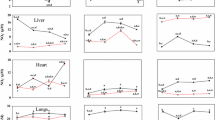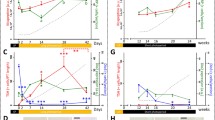Abstract
This study examined the effects of pinealectomy in Wistar rats and melatonin replacement therapy on the daily mRNA expression of melatonin (Tph1, Aanat, Asmt, Mt1, Mt2, and Rorα), and steroidogenic (Star, 17βhsd3, and Lhr) related genes as well as clock genes (Rev-erbα, Bmal1, Per1, Per2, Cry1, and Cry2) in testes. The testes of control animals express the Tph1, Aanat, and Asmt and Per2 genes with 24-h rhythms in mRNA, reaching the maximal values during the dark phase. Pinealectomy abolished and melatonin treatment restored the 24-h rhythmicity. Daytime differences in mRNA expression were significant for Star, Lhr, Mt1, Mt2, Rorα, Rev-erbα, Bmal1, Cry1, and Cry2 genes in testes of control rats. Conversely, 17βhsd3 and Per1 mRNA expression did not show a daytime difference in testes of control animals. Pinealectomy abolished the peak time of Mt1 and Mt2 mRNA expression, phase shifted the peak time of Star, Rorα, Rev-erbα, Bmal1, and Cry2 mRNA expression, downregulated the 24-h Lhr mRNA expression, and inverted the peak time of Per1, Per2, and Cry1 mRNA expression to the light phase. The melatonin replacement therapy completely restored the control levels of Lhr, Rev-erbα, and Per1 mRNA expression patterns, partially restored the daily control of Star, Mt2, Rorα, Bmal1, Cry1, and Cry2 mRNA expression but did not re-establish the daily control of Mt1 mRNA expression. This suggests that the daily mRNA expression of these genes is probably driven by pineal melatonin and melatonin treatment restores (partially or completely) the daily control of gene expression patterns.





Similar content being viewed by others
References
Reiter RJ, Fraschini F (1969) Endocrine aspects of the mammalian pineal gland: a review. Neoroendocrinology 5:219–255
Cipolla-Neto J, Amaral FG (2018) Melatonin as a hormone: new physiological and clinical insights. Endocr Rev 39:990–1028
Rath MF, Coon ST, Amaral FG, Weller JL, Møller M, Klein DC (2016) Melatonin synthesis: acetylserotonin O-methytransferase (ASMT) is strongly expressed in a subpopulation of pinealocytes in the male rat pineal gland. Endocrinology 157:2028–2040
Simonneaux V, Ribelayga C (2003) Generation of the melatonin endocrine message in mammals: a review of the complex regulation of melatonin synthesis by norepinephrine, peptides, and other pineal transmitters. Pharmacol Rev 55:325–395
Reiter RJ (1993) The melatonin rhythm: both a clock and a calendar. Experientia 49:654–664
King DP, Takahashi JS (2000) Molecular genetics of circadian rhythms in mammals. Annu Rev Neurosci 23:713–742
Vriend J, Reiter RJ (2015) Melatonin feedback on clock genes: a theory involving the proteasome. J Pineal Res 58:1–11
Torres-Farlan C, Seron-Ferre M, Dinet V, Korf H-W (2006) Immunocytochemical demonstration of day/night changes of clock gene protein levels in the murine adrenal gland: differences between melatonin-proficient (C3H) and melatonin-deficient (C57BL). J Pineal Res 40:64–70
Alonso-Vale MIC, Andreotti S, Mukai PY, Lima FHB (2008) Melatonin and the circadian entrainment of metabolic and hormonal activities in primary isolated adipocytes. J Pineal Res 45:422–429
Farias TSM, Chimin P, Oliveira AC, Amaral FG, Chimin P, Proença ARA, Leal FLT, Sertié RAL et al (2015) Pinealectomy interferes with the circadian clock genes expression in white adipose tissue. J Pineal Res 58:251–261
Acuña-Castroviejo D, Escames G, Venegas C, Diaz-Casado ME, Lima-Cabello E, López LC, Rosales-Corral S, Tan DX et al (2014) Extrapineal melatonin: sources, regulation, and potential functions. Cell Mol Life Sci 71:2997–3025
Sakaguchi K, Itoh MT, Takahashi N, Tamuri W, Ishizuka B (2013) The rat oocyte synthesizes melatonin. Reprod Fertil Dev 25:674–682
Coelho LA, Peres R, Amaral FG, Reiter RJ, Cipolla-Neto J (2015) Daily differential expression of melatonin-related genes and clock genes in rat cumulus-oocyte complex: Changes after pinealectomy. J Pineal Res 58:490–499
He C, Wang J, Zhang Z, Yang M, Li Y, Tian X, Ma T, Tao J et al (2016) Mitochondria synthesize melatonin to ameliorate its function and improve mice oocyte’s quality under in vitro conditions. Int J Mol Sci 17:939. https://doi.org/10.3390/ijms17060939
Gonzalez-Arto M, Hamilton TRS, Gallego M, Gaspar-Torrubia E, Aguilar D, Serrano-Blesa E, Abecia JA, Pé-Pérez R et al (2016) Evidence of melatonin synthesis in the ram reproductive tract. Andrology 4:163–171
Tijmes M, Pedraza R, Valladares L (1996) Melatonin in the rat testis: evidence for local synthesis. Steroids 61:65–68
Itoh MT, Ishizuka B, Kuribayashi Y, Amemiya A, Sumi Y (1999) Melatonin, its precursors, and synthesizing enzyme activities in the human ovary. Mol Hum Reprod 5:402–408
Li C, Zhou X (2015) Melatonin and male reproduction. Clin Chim Acta 446:175–180
Frungieri MB, Mayerhofer A, Karina Zitta K, Pignataro OP, Calandra RS, Gonzalez-Calvar SI (2005) Direct effect of melatonin on Syrian hamster testes: melatonin subtype 1a receptors, inhibition of androgen production, and interaction with the local corticotropin-releasing hormone system. Endocrinology 146:1541–1552
Qin F, Zhang J, Zan L, Guo W, Wang J, Chen L, Cao Y, Shen O et al (2015) Inhibitory effect of melatonin on testosterone synthesis is mediated via GATA-4/SF-1 transcription factors. RBM Online 31:638–646
Reiter RJ, Rosales-Corral S, Tan DX, Jou MJ, Galano A, Xu B (2017) Melatonin as a mitochondria-targeted antioxidant: one of evolution’s best ideas. Cell Mol Life Sci 74:3863–3881
Vera H, Tijmes M, Ronco AM, Valladares L (1993) Melatonin binding sites in interstitial cells from immature rat testes. Biol Res 26:337–340
Izzo G, Francesco A, Ferrara D, Campitiello MR, Serino I, Minucci S, d’Istria M (2010) Expression of melatonin (MT1, MT2) and melatonin-related receptors in the adult rat testes and during development. Zygote 18:257–264
Pozo D, Garcia-Mauriño S, Guerrero JM, Calvo JR (2004) mRNA expression of nuclear receptor RZR/RORα, melatonin membrane receptor MT1 and hydroxindole-O-methytranferase in different populations of human immune cells. J Pineal Res 37:48–54
Smirnov AN (2001) Nuclear melatonin receptors. Biochemistry 66:19–26
Venegas C, García JA, Doerrier HV, Volt H, Escames G, López LS, Reiter RJ, Acuña-Castroviejo D (2013) Analysis of the daily changes of melatonin receptors in the rat liver. J Pineal Res 54:313–321
Hoffman RA, Reiter RJ (1965) Rapid pinealectomy in hamsters and other small rodents. Anat Rec 53:19–22
Livak KJ, Schmittgen TD (2001) Analysis of relative gene expression data using real-time quantitative PCR and the 2-ΔΔCT method. Methods 25:402–408
Vandesompele J, De Preter K, Pattyn F, Poppe B, Roy NV, De Paepe A, Speleman F (2002) Accurate normatization of real-time quantitative RT-PCR data by geometric averaging of multiple internal control genes. Genome Biol 3:RESEARCH0034
Nelson W, Tong YL, Lee JK, Halberg F (1979) Methods for cosinor-rhythmometry. Chronobiologia 6:305–323
Stefulj J, Hörtner M, Ghosh M, Schauenstein K, Rinner I, Wölfler A, Semmler J, Liebmann M (2001) Gene expression of the key enzymes of melatonin synthesis in extrapineal tissues of the rat. J Pineal Res 30:243–247
Luboshitzky R, Shen-Orr HP (2002) Seminal plasma melatonin and gonadal steroids concentrations in normal men. Arch Androl 48:225–232
Rossi SP, Windschetti S, Matzkin ME, Terradas C, Ponzio R, Puigdomenech E, Levalle O, Calandra RS et al (2014) Melatonin in testes of infertile men: evidence for anti-proliferative and anti-oxidant effects on local macrophage and mast cell populations. Andrology 2:436–449
Rossi SP, Matzkin ME, Terradas C, Ponzio R, Puigdomenech E, Levalle O, Calandra RS, Frungieri MB (2012) New insights into melatonin/CRH signaling in the hamster Leydig cells. Gen Comp Endocrinol 178:153–163
Stocco DM, Clark BJ (1996) Regulation of the acute production of steroids in steroidogenic cells. Endocr Rev 17:221–244
Qin F, Zhang J, Cao H, Guo W, Chen L, Shen O, Sun J, Yi C et al (2014) Circadian alterations of reproductive functional markers in male rats exposed to 1800 Mhz radiofrequency field. Chronobiol Int 31:123–133
Liu X, Xu Y, Shi Q, Lu Q, Ma S, Xu X, Guo X (2013) Alterations of reproductive hormones and receptors of male rats at the winter and summer solstices and the effects of pinealectomy. Neuroendocrinol Lett 34:143–153
Stocco DM, Wang X, Jo Y, Manna PR (2005) Multiple signaling pathways regulating steroidogenesis and steroidogenic acute regulatory protein expression: more complicated than we thought. Mol Endocrinol 19:2647–2659
Wu C-S, Leu S-F, Yang H-Y, Huang B-M (2001) Melatonin inhibits the expression of steroidogenic acute regulatory protein and steroidogenesis in MA-10 cells. J Androl 22:245–254
González-Arto M, Vicente-Carrillo A, Martinez-Pastor F, Fernández-Alegre E, Roca J, Miró J, Rigau T, Rodríguez-Gil JE et al (2016) Melatonin receptors MT1 and MT2 are expressed in spermatozoa of several seasonal and nonseasonal breeder species. Theriogenology 86:1958–1968
Espino J, Ortiz A, Bejarano I, Lozano GM, Monllor F, García JF, Rodríguez AB, Pariente JA (2011) Melatonin protects human spermatozoa from apoptosis via melatonin receptor- and extracellular signal-regulated kinase-mediated pathways. Fertil Steril 95:2290–2296
Dubocovich ML, Yun K, Al-Ghoul WM, Benloucif S, Masana MI (1998) Selective MT2 melatonin receptor antagonists block melatonin-mediated phase advances of circadian rhythms. FASEB J 12:1211–1220
Nakajima Y, Ikeda M, Kimura T, Honma S, Ohmiya Y, Honma K (2004) Bidirectional role of orphan nuclear receptor RORα in clock gene transcriptions demonstrated by a novel reporter assay system. FEBS Lett 565:122–126
Kennaway DJ, Boden MJ, Varcoe TJ (2012) Circadian rhythms and fertility. Mol Cell Endocrinol 349:56–61
Alvarez JD, Hansen A, Ord T, Bebas P, Chappell PE, Giebultowicz JM, Williams C, Moss S et al (2008) The circadian clock protein BMAL1 is necessary for fertility and proper testosterone production in mice. J Biol Rhythm 23:26–36
Reiter RJ (1968) The pineal gland and gonadal development in male rats and hamsters. Fertil Steril 19:1009–1017
Majrashi KAA, Barakat IAH, Al-Himaidi AR, Adham KG (2017) Effects of exogenous melatonin treatment on the reproductive characteristics and progeny of male rats exposed to different periods from light and darkness. Physiol Res 66:507–518
Funding
This work was financially supported by the Fundação de Amparo à Pesquisa do Estado de São Paulo, FAPESP (2014/17830-9), FAPESP (2014/50457-0), São Paulo, Brazil.
Author information
Authors and Affiliations
Corresponding author
Ethics declarations
Conflict of Interest
The authors declare that they have no conflict of interest.
Additional information
Publisher’s Note
Springer Nature remains neutral with regard to jurisdictional claims in published maps and institutional affiliations.
Rights and permissions
About this article
Cite this article
Coelho, L.A., Andrade-Silva, J., Motta-Teixeira, L.C. et al. The Absence of Pineal Melatonin Abolishes the Daily Rhythm of Tph1 (Tryptophan Hydroxylase 1), Asmt (Acetylserotonin O-Methyltransferase), and Aanat (Aralkylamine N-Acetyltransferase) mRNA Expressions in Rat Testes. Mol Neurobiol 56, 7800–7809 (2019). https://doi.org/10.1007/s12035-019-1626-y
Received:
Accepted:
Published:
Issue Date:
DOI: https://doi.org/10.1007/s12035-019-1626-y




